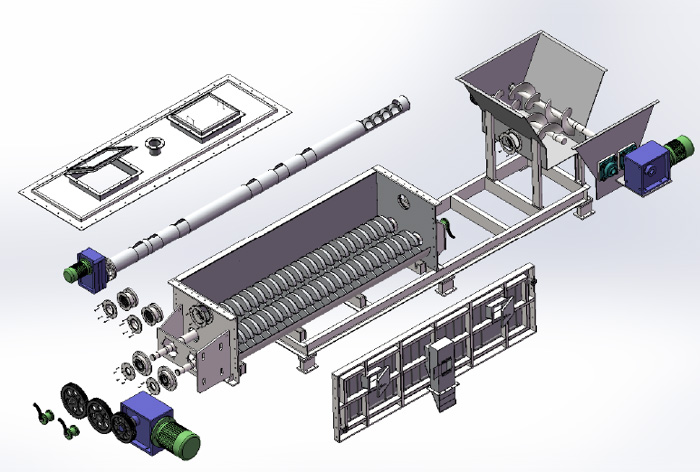sludge dryers wastewater system
Why do wastewater sludge drying?
The wastewater treatment process is accompanied by the generation of sludge, the large amount of sludge and high water content, complicated processing, high difficulty and high cost. The wastewater produced by most industrial production processes is complex and difficult to be directly biochemically treated. It needs to be discharged after physicochemical, biochemical and advanced treatment. For example, in the production process of toluene diisocyanate, the physicochemical sludge produced in the wastewater treatment process. And the biochemical sludge, after centrifugation, the water content is as high as 80±5wt%, and the annual output is 6000-8000 tons. It needs to be transported by the designated processing unit for transportation. The transportation process is heavy and the transportation cost is high; the existing treatment Technology, large workload, high cost, mechanical filtration has limited capacity for sludge reduction, and treated emissions will still cause environmental pollution. To achieve sludge reduction, reduce the overall operating cost of wastewater treatment systems, and reduce wastewater. The environmental impact of the treated sludge, RD developed the sludge dryers wastewater system.

Difficulties in sludge dryers wastewater?
In the drying process, it is necessary to provide heat to the Materials to be dried, so that the water content of the water is vaporized and removed, so the drying process consumes a large amount of energy, and the energy consumption problem of the project with a large material handling amount is particularly prominent. Environmental protection industry, the waste drying method is reduced, harmless, and resource-treated, such as sludge, high-concentration salt water, etc., the drying process consumes too much energy, and the treatment cost is too high, which seriously affects The enterprise. Economic benefits. At the same time, it also seriously affects the social benefits of environmental protection. On the other hand, in the drying process, the vaporized volatilized wa At the time of the drying process and equipment have various forms. For the drying of materials or agricultural by-products in industrial products and industrial processes The problem of energy consumption is not prominent, but in the emerging environmental protection industry, the problem of reduced energy consumption in the drying process is extremely prominent. . In order to save energy and reduce energy consumption, people in a variety of drying processes And equipment screening, most of the use of conductive heating drying technology is more energy efficient, therefore, based on the conduction heating drying technology, the current project to carry out research on new processes, to achieve The drying process.
Does RD give the solution to sludge dryers wastewater?
1. Successfully developed an ideal energy-saving drying system to meet the requirements of expected results;
2. The system structure includes one-effect dryer, two-effect dryer and primary heat source system; one-effect dryer is positive pressure dryer, second-effect dryer is vacuum negative pressure dryer; secondary steam recovery and utilization heat source system is located In one A plurality of dry dust collectors at the top of the effect dryer are connected by a pipeline and a wet dust collector; the sealed feeding system is composed of a distribution silo and a cloth spiral, and an output end for feeding the two dryers Is respectively arranged for the water-containing powder Sealed feed of bulk material and paste material and bulk filter cake material;
3. The one-effect dryer feeding process: the material to be dried is added to the cavity by the sealing feeding system, and the sealing feeding system is composed of the distribution silo and the cloth spiral. The feeding amount is realized by the automatic control The sealing property of the sealing feeding system is The seal is completed by the material; the airtight state remains valid regardless of the state of the feed or the stop of the feed;
4. The heat from the boiler enters the main shaft cavity of the dryer through a primary heat source steam system. After heat exchange, the phase changes into condensed water, And the discharged condensed water is drained. After the system Return to the boiler; the flash steam generated in the hydrophobic process is collected by the flash steam recovery and utilization system, and the flash steam is merged with the clean steam at the output end of The secondary steam recovery heat source system to serve as a heat source for the secondary effect dryer.
5. The discharge process of the first-effect dryer: the dry material after passing through the differential pressure isolation system is discharged into the second-effect dryer; the differential pressure isolation system is composed of the control valve and the buffer tank; The pressure isolation system is controlled by the control system The control valve not only ensures the dry material discharge after drying of the one-effect dryer, but also ensures the pressure difference isolation of the dryer, keeps the one-effect dryer running under positive pressure and The second-effect dryer under negative pressure;
6. The tail gas discharge process of the first-effect dryer, the tail gas discharge is a dusty steam with pressure, which is completed by the secondary steam recovery and utilization of the heat source system, and is used as a heat source of the second-effect dryer after dust removal and purification;
7. The feeding process of the second-effect dryer: First, the material to be dried is added by the sealing feeding system, and then enters the cavity of the second-effect drying machine; the sealing feeding system is composed of the distribution silo and the cloth spiral, and the feeding amount is realized by the automatic control system; The sealing property is completed by material sealing; the gas-tight state remains effective regardless of the feeding state or the feeding stop state; the second is to add the second-effect dryer by the differential pressure isolation system;
8. Two-effect dryer heating and drying process: The first heat source used in the second-effect dryer is the secondary steam recovery and the clean steam with pressure processed by the heat source system; the second is the steam condensate passing through the first-effect dryer. The flashing steam that has been flashed is sent to the second-effect dryer as a heat source through the flash steam collected by the hydrophobic flash steam recovery system; the third source of heat source is from the secondary steam replenishing system, and the current two When the heat source is not enough to drive the second-effect dryer, it is supplemented by the secondary steam replenishing system; it is to pass the steam heat source of the heating primary heat source system into the casing of the first-effect dryer, and becomes the low-pressure hot steam to increase the exhaust gas discharge. At the same time, it has auxiliary drying effect on the first-effect dryer, and has overheat protection for the secondary steam recovery and utilization system, so that the dust-free steam is not condensed and blocked in the dust collector and pipeline in the secondary steam recovery and utilization system, and the steam is supplemented. The pressure is controlled by a regulator valve;
9. The discharge process of the two-effect dryer: the two-effect dryer is vacuum drying, the pressure inside the casing is less than the ambient atmospheric pressure during the drying process; the dried material is discharged by the sealing discharge system; the sealing discharge system is The automatic control valve and the buffer material tube are configured to discharge the material of the second-effect dryer after drying, but the sealed discharge system is always isolated from the ambient atmosphere, and the negative-pressure state of the second-effect dryer is maintained by the control system. control;
10. Exhaust gas discharge process of the second-effect dryer: the exhaust gas discharged is the vacuum of the negative-pressure dust. The tail gas treatment is completed by the dry exhaust gas vacuum system, which consists of the dust collector and the condenser; that is, the dust is removed by the wet dust collector. After condensing the volatilized steam, the vacuum unit is taken out without condensation, and the condensed water discharged from the condenser is discharged into the sewage treatment system; the vacuum state in the second-effect dryer is established and maintained by the exhaust vacuum system to reduce and keep the material wet. The volatilization temperature of the fraction; thereby maintaining a large temperature gradient between the heat source and the material to be dried, thereby improving the drying efficiency;
11. Overall, the first-effect dryer used for positive pressure drying has the purpose of having a certain steam pressure for the secondary steam discharged, and can be used as a heat source for the two-effect dryer. The purpose of the vacuum drying of the two-effect dryer is to increase the temperature gradient of the heat source and the material to be dried, and to improve the drying efficiency of the two-effect dryer;
12. The primary heat source system used is a steam heat carrier. In the heat source system of the steam heat carrier, the steam condensate of the first-effect dryer passes through the steam trap and returns to the boiler to realize heat recovery and desalinated water recovery; The flashing steam passes through the flash steam recycling system into the secondary steam recovery and uses the heat source system as the heat source of the second-effect dryer; when the secondary dust-containing steam generated by the first-effect dryer is insufficient to drive the second-effect dryer, Supplemented by the secondary steam replenishment system, this system is to pass the primary heat source steam of the heating one-effect dryer into the casing of the one-effect dryer, and to become the super-low pressure hot steam, which has the auxiliary drying effect on the one-effect dryer, and at the same time The secondary steam recovery and utilization system has a superheat protection function, so that the dust-containing steam is not condensed and blocked in the dust collector and the pipeline in the secondary steam recovery and utilization system, and the pressure of the supplementary steam used is controlled by the pressure regulating valve;
13. The tail gas treatment discharged by the two-effect dryer is completed by the dry exhaust gas vacuum system. After the dust is removed by the wet dust collector, it enters the condenser, and after the volatile steam is condensed, the non-condensable gas is taken out by the vacuum unit. The exhaust vacuum system establishes and maintains the vacuum state in the two-effect dryer, reduces and maintains the volatilization temperature of the moisture content of the material; thereby maintaining a large temperature gradient between the heat source and the material to be dried, and improving the drying efficiency;
14. The sealed feeding system is completed by material sealing. The sealing state remains valid regardless of the state of the feed or the state of the feed stop. For aqueous powder materials and paste materials as well as bulk filter cake materials, the sealed feed system consists of a distribution silo and a cloth spiral. The first-effect dryer and the second-effect dryer are separately added, and the control of the feeding amount is completed by the automatic control system.
Sludge dryer wastewater system
Reverse spiral design: In order to avoid the sludge in the process of sludge drying, the front end mechanism will cause wear of the shaft seal or bearing mud due to sludge accumulation or long-term extrusion, which will affect its service life. The unit is equipped with a reverse spiral on the blade shaft to reduce sludge accumulation or extrusion and ensure the service life of the unit.
Design replaceable wear plates: The dry spindle scraper is designed to be weldable. The annual manufacturer must check the steel wear. When the wear exceeds the control value (50% thickness), it should be replaced at the next repair time. The wear exceeds For warning values (thickness 75%), immediately suspend operation to repair the spindle scraper.
